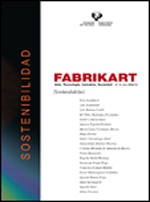Sustainability in the process of visual identification of public utility
##plugins.themes.bootstrap3.article.main##
##plugins.themes.bootstrap3.article.sidebar##
Abstract
Social organizations have always used different recourses to present themselves to the public. Visual elements that have become identification signs that symbolize their essence, their actions and their future intentions.
From inside the public institutions a reflection must exist that establishes a true strategy of public communication. On the one hand, citizens must receive clear and precise information by means of documents managed and published by the institutions. On the other hand, one must not forget the graphic qualities understood as eco-graphic that help to make our immediate surroundings a place more hospitable, human and beautiful. If it is not so, the work of the design professional would be seen as limited to an aesthetic function, to make-over and delight, re-using old devices of publicity and advertising seduction, pulling us towards visual contamination.
We find ourselves in a period of change, the capitalist system is in a state of crisis which questions a whole series of "truths" accepted without consideration. It is evident that a system such as the one of brand is the result of an industrial upsurge in western society where the city, territory or country has abandoned its status as geographic entity or administrative unit to convert to develop functions of symbols of identity and space for political and economical speculation.

